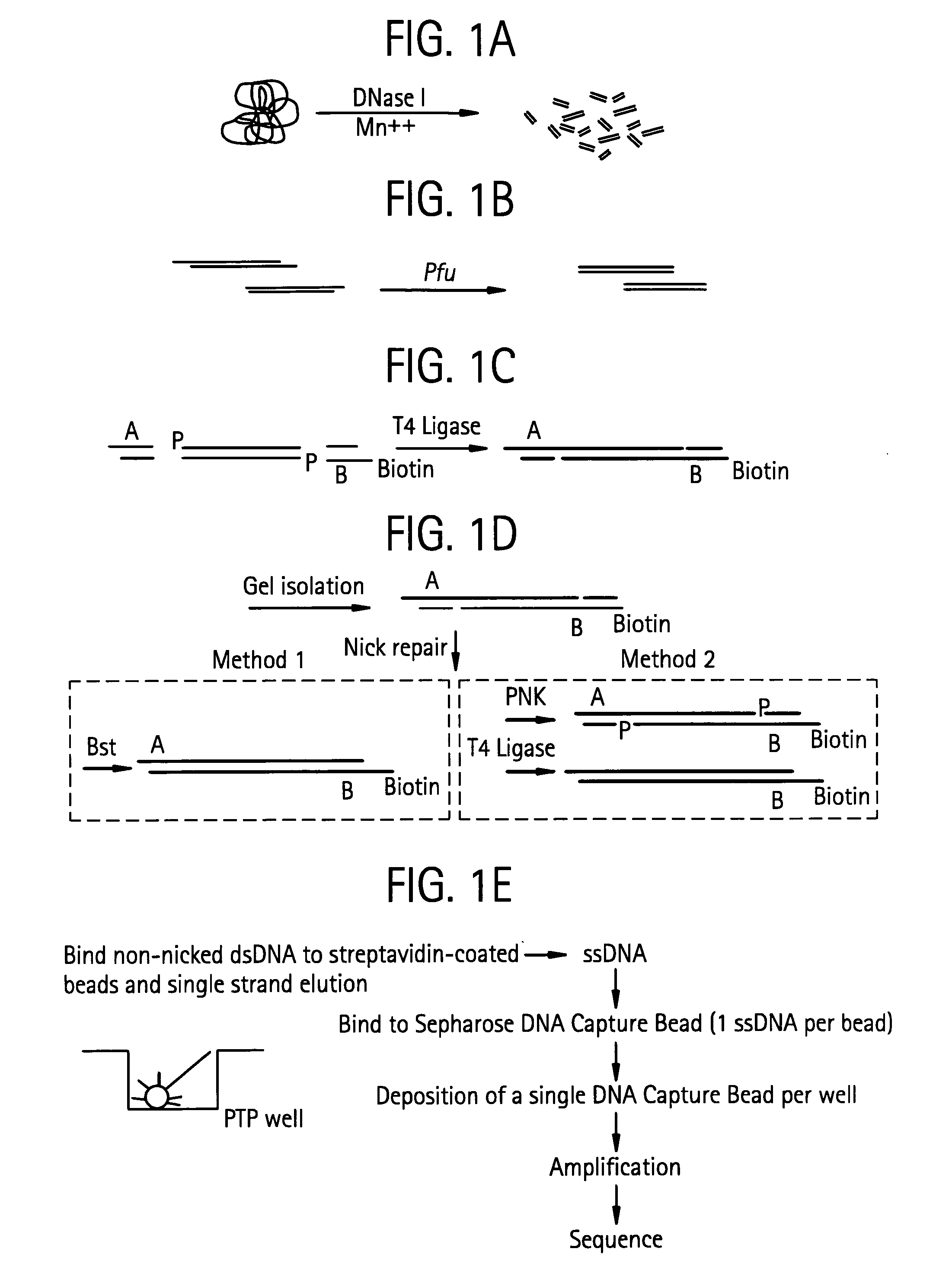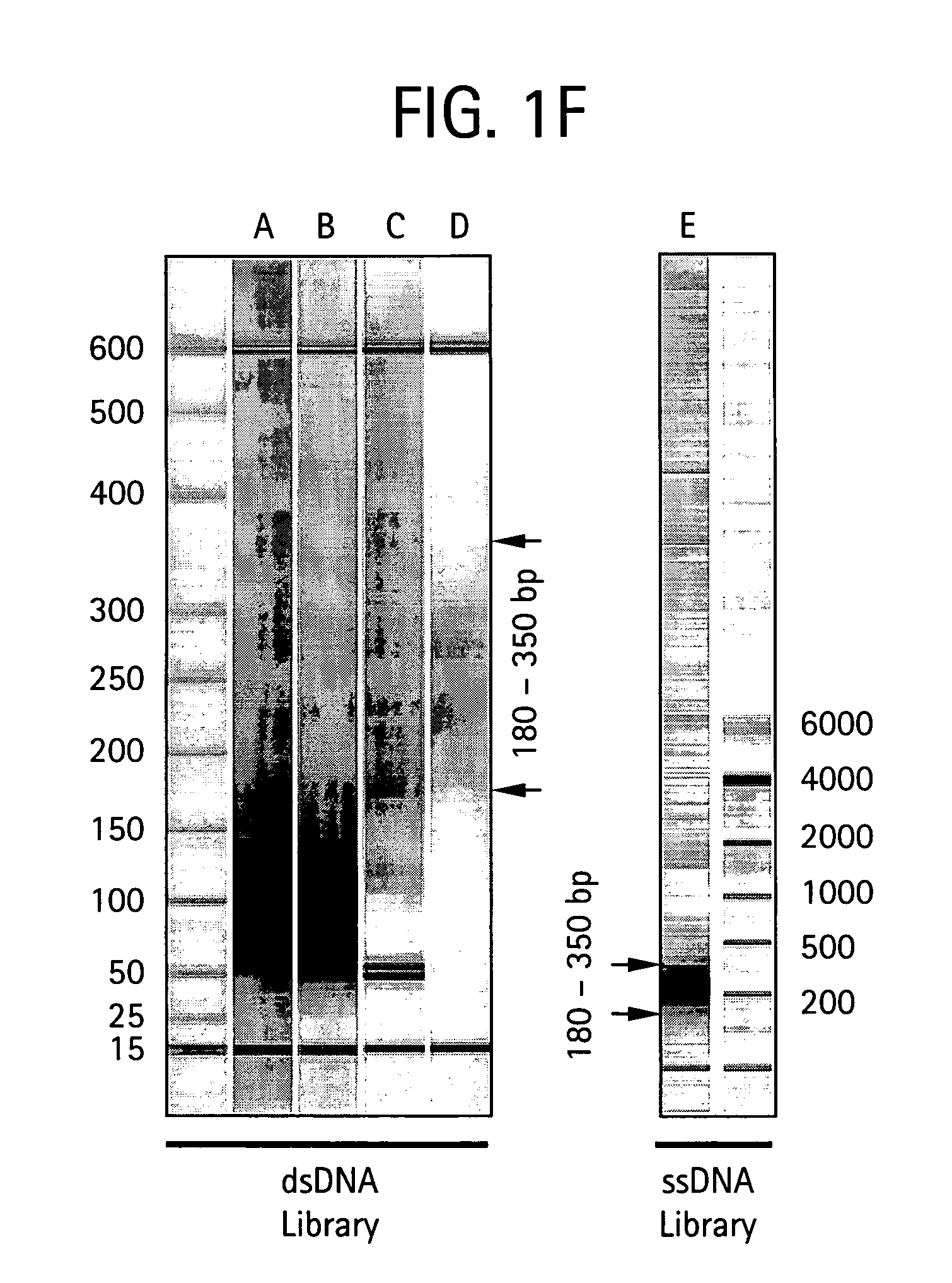Methods of amplifying and sequencing nucleic acids
a nucleic acid and amplifying technology, applied in the field of methods of amplifying and sequencing nucleic acids, can solve the problems of inaccurate sample preparation, sequence analysis of genomes, amplification and sequencing, etc., and achieve the effect of low background
- Summary
- Abstract
- Description
- Claims
- Application Information
AI Technical Summary
Benefits of technology
Problems solved by technology
Method used
Image
Examples
example 1
DNA Sample:
[0313] The DNA should be of high quality and free from contaminants such as proteins, nucleases, lipids, and other chemicals (such as residual EDTA from preparation) and salts. It is preferred that genomic DNA should have a 260 / 280 ratio of 1.8 or higher. If it is desired to sequence the genome of only one organism, then the DNA should be quality checked to ensure that there is no contaminating DNA. For example: a preparation of human DNA may be checked by PCR to ensure that it is not contaminated by bacterial DNA molecules. Another method of checking for contamination is by restriction digestion patterns and especially restriction digestion followed by Southern Blot using suitable probes known to be specific for an organism (e.g., human or mouse) and a second probe known to be specific for a possible contaminating organism (e.g., E. coli). If it is desired, the DNA should originate from a single clone of the organism (e.g., a colony if from bacteria)...
example 2
Primer Design
[0405] As discussed above, the universal adaptors are designed to include: 1) a set of unique PCR priming regions that are typically 20 bp in length (located adjacent to (2)); 2) a set of unique sequencing priming regions that are typically 20 bp in length; and 3) optionally followed by a unique discriminating key sequence consisting of at least one of each of the four deoxyribonucleotides (i.e., A, C, G, T). The probability of cross-hybridization between primers and unintended regions of the genome of interest is increased as the genome size increases and length of a perfect match with the primer decreases. However, this potential interaction with a cross-hybridizing region (CHR) is not expected to produce problems for the reasons set forth below.
[0406] In a preferred embodiment of the present invention, the single-stranded DNA library is utilized for PCR amplification and subsequent sequencing. Sequencing methodology requires random digestion of a given genome into ...
example 3
Sample Preparation by Nebulization
Preparation of DNA by Nebulization
[0414] The purpose of the Nebulization step is to fragment a large stretch of DNA such as a whole genome or a large portion of a genome into smaller molecular species that are amenable to DNA sequencing. This population of smaller-sized DNA species generated from a single DNA template is referred to as a library. Nebulization shears double-stranded template DNA into fragments ranging from 50 to 900 base pairs. The sheared library contains single-stranded ends that are end-repaired by a combination of T4 DNA polymerase, E. Coli DNA polymerase I (Klenow fragment), and T4 polynucleotide kinase. Both T4 and Klenow DNA polymerases are used to “fill-in” 3′ recessed ends (5′ overhangs) of DNA via their 5′-3′ polymerase activity. The single-stranded 3′-5′ exonuclease activity of T4 and Klenow polymerases will remove 3′ overhang ends and the kinase activity of T4 polynucleotide kinase will add phosphates to 5′ hydroxyl te...
PUM
| Property | Measurement | Unit |
|---|---|---|
| width | aaaaa | aaaaa |
| width | aaaaa | aaaaa |
| width | aaaaa | aaaaa |
Abstract
Description
Claims
Application Information
 Login to View More
Login to View More - R&D
- Intellectual Property
- Life Sciences
- Materials
- Tech Scout
- Unparalleled Data Quality
- Higher Quality Content
- 60% Fewer Hallucinations
Browse by: Latest US Patents, China's latest patents, Technical Efficacy Thesaurus, Application Domain, Technology Topic, Popular Technical Reports.
© 2025 PatSnap. All rights reserved.Legal|Privacy policy|Modern Slavery Act Transparency Statement|Sitemap|About US| Contact US: help@patsnap.com



